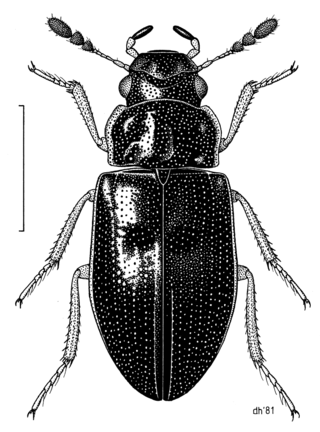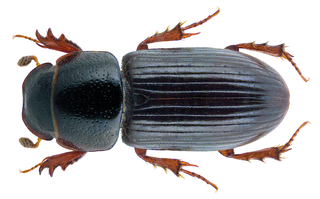
Beetles are insects that form the order Coleoptera, in the superorder Holometabola. Their front pair of wings are hardened into wing-cases, elytra, distinguishing them from most other insects. The Coleoptera, with about 400,000 described species, is the largest of all orders, constituting almost 40% of described insects and 25% of all known animal species; new species are discovered frequently, with estimates suggesting that there are between 0.9 and 2.1 million total species. Found in almost every habitat except the sea and the polar regions, they interact with their ecosystems in several ways: beetles often feed on plants and fungi, break down animal and plant debris, and eat other invertebrates. Some species are serious agricultural pests, such as the Colorado potato beetle, while others such as Coccinellidae eat aphids, scale insects, thrips, and other plant-sucking insects that damage crops. Some others also have unique characteristics, such as the common eastern firefly, which uses a light-emitting organ for mating and communication purposes

Parcoblatta fulvescens, the fulvous wood cockroach, is a species of cockroach endemic to the United States and possibly Canada that measures around 13 mm (0.5 in) long.

The Mordellidae are a family of beetles commonly known as tumbling flower beetles for the typical irregular movements they make when escaping predators, or as pintail beetles due to their abdominal tip which aids them in performing these tumbling movements. Worldwide, there are about 1500 species.
Mordellina is a genus of tumbling flower beetles in the family Mordellidae.

Mordellistena is a genus of beetles in the family Mordellidae, containing the following species:
Pseudotolida is a genus of tumbling flower beetles in the family Mordellidae. There are at least 20 described species in Pseudotolida.
Mordellistena goetzi is a species of beetle belonging to the family Mordellidae, which is commonly known as tumbling flower beetles. These beetles are small in size, typically measuring between 2 and 6 millimeters in length, and are characterized by their narrow and elongated bodies.

Mordellistena subfuscus is a species of beetle in the genus Mordellistena of the family Mordellidae. It was described by Liljeblad in 1945.
Mordellistena syntaenia is a species of beetle in the genus Mordellistena of the family Mordellidae. It was described by Liljeblad in 1921.
Mordellistena tantula is a species of beetle in the genus Mordellistena of the family Mordellidae. It was described by Liljeblad in 1945.
Mordellistena vera is a species of beetle in the genus Mordellistena of the family Mordellidae. It was described by Liljeblad in 1917.
Mordellistena viridescens is a species of beetle in the genus Mordellistena of the family Mordellidae. It was described by Liljeblad in 1945.
Mordellistena wenzeli is a species of beetle in the genus Mordellistena of the family Mordellidae. It was described by Liljeblad in 1945.
Mordellistena wickhami is a species of beetle in the genus Mordellistena of the family Mordellidae. It was described by Liljeblad in 1945.
Mordellistena wolcotti is a species of beetle in the genus Mordellistena of the family Mordellidae. It was described by Liljeblad in 1917.

Mordellinae is a subfamily of beetles commonly known as tumbling flower beetles for the typical irregular movements they make when escaping predators, or as pintail beetles due to their abdominal tip which aids them in performing these tumbling movements.

Cassida viridis, common name green tortoise beetle, is a species of beetle in the leaf beetle family (Chrysomelidae).
Psylliodes luridipennis, commonly known as the Lundy cabbage flea beetle or the bronze Lundy cabbage flea beetle, is a species of flea beetle endemic to the island of Lundy, where it lives and feeds upon the endemic Lundy cabbage. Along with the true weevil Ceutorhynchus contractus var. pallipes and an undescribed race of flea beetle Psylliodes napi, it is known only from the Lundy cabbage. The species was first recorded by Thomas Vernon Wollaston in the 1840s, and was named by the Austrian entomologist Franz Kutschera in 1864.

Horelophus walkeri is a small water scavenger beetle that is endemic to New Zealand. It is found in the South Island in the West Coast, Nelson, Buller and Marlborough regions. The preferred habitat of this species are the moss and crevices within the splash zone of waterfalls sourced from fast flowing, clear, cool waterways. The larvae of this species are carnivorous while the adults are herbivores or scavengers. In 2012 the Department of Conservation classified this beetle as Nationally Endangered.

Liothorax kraatzi is a species of dung beetle with a widespread distribution from Southeastern Europe, Asia Minor, to Caucasus, and Central Asia.








